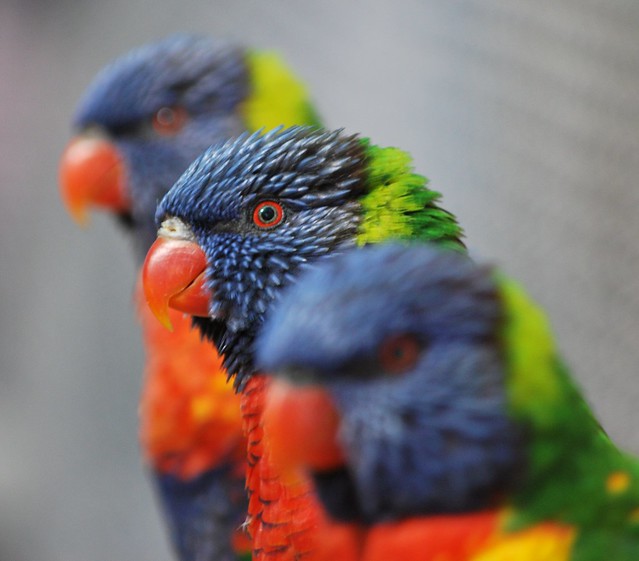 |
| Lories - Photo by foqus (cc) |
Zara is a Blue-Streaked Lory and she is now 11 years old. She is quite the pistol and very animated. When we adopted her we didn't know what we were in for. Though I should have known when I left the zoo and the little escapologist hid in my bag. She has the most beautiful colorings I have seen. She is primarily red with black dispersed in her feathers. She has two dark blue streaks from the corner of her eyes and red with sky blue tips on her neck. She doesn't have belly feathers as she plucks which is now out of habit even though, she is still very beautiful.
and she is now 11 years old. She is quite the pistol and very animated. When we adopted her we didn't know what we were in for. Though I should have known when I left the zoo and the little escapologist hid in my bag. She has the most beautiful colorings I have seen. She is primarily red with black dispersed in her feathers. She has two dark blue streaks from the corner of her eyes and red with sky blue tips on her neck. She doesn't have belly feathers as she plucks which is now out of habit even though, she is still very beautiful.
There are two species. Lories which have short blunt tails and Lorikeets which have long tapering tails; though this usage can be subjective like parrot and parakeet. They are widely distributed within the Australian region, south-eastern Asia, Polynesian Islands, Papua New Guinea and Timor Leste.
Their plumage is very eye-catching and colorful. Because they are small and extremely beautiful many people want them. Like any parrot, the owner needs to be educated to Lory's special needs, particularly their specialized diet of a nectar replacement. Their droppings are very messy as it is mostly liquid.
We now have Zara a Blue-Streak Lory living amongst the flock and she is different from our other three as they are hookbills and eat a very different diet than Zara. Hookbills have the ability to open nuts and they eat the seed. It is dangerous for a Lory to eat seed as their esophagus lining is very thin and it could literally rip the esophagus lining and kill a Lory.
As to the diet a Lory eats, it sounds complex but it is actually very easy as they eat nectar, juice, fruit, and vegetables. When I feed Zara I mix her nectar powder with water and the temperature should be around 100 degrees Fahrenheit and made into syrup. She also has dry nectar that is near her water.
Lories have a specialized brush tipped-tongue (tufts of papillae, extremely fine hairs) which she uses to pick up her dry nectar and mix with water. Consequently, her droppings are very messy as her diet consists mostly of liquid.
The Ultramarine Lorikeet is endangered as it is one of the 50 rarest parrots in the wild. The Blue Lorikeet is classified as vulnerable because of the introduction of European rats to the small island habitats in which they live. There have been conservation efforts in relocating these colorful clowns to locations free of predation and destruction.
Zara also eats fresh fruit like cantaloupe, apples, oranges, and berries on her fruit kabob. At night I give her a bowl of mixed veggies. Get the frozen veggie bag with peas, carrots, carrots and green beans. Just take out the green beans and lima beans as they are high in iron and Lories cannot break down iron in their liver. Lories are very iron sensitive. To help break down iron in Lory's liver I give Zara milk thistle (alcohol-free!!). As a treat, I give her one grape and she loves it. When feeding a Lory, always check the iron ratio. Lories are a little time-consuming but the reward is immeasurable!
Lories and Lorikeets are very playful, animated and the class clown. They are very mischievous so they do have to be in a cage when they are left alone. When I leave the house I put Zara in her cage and while we sleep. When Zara sleeps I cover her cage; it gives a sense of security like a child with a blanket.
As I have said Lories and Lorikeets are a very special breed of parrots and require a lot of attention. Keep in mind they are like a domesticated hummingbird only in parrot form.
are a very special breed of parrots and require a lot of attention. Keep in mind they are like a domesticated hummingbird only in parrot form.
Lories and Lorikeets are very high-strung and have a lot of energy because the nectar is mainly made up of sugars, their fruit has a lot of sugar and the juice they drink is made up of sugars. They are always on the go. Keeping this in mind they are very enticing as they are small and extremely colorful.
I can leave my other three feathered friends out of their cages when I leave and they will still be sitting where I left them when I get home. Zara, on the other hand, will have roamed the house and needless to say I have to search the house for her.
Zara may seem like a lot of work but she well worth it. I am very pleased she has joined our flock.

Hii your article is amazing. this is wonderful post. you should see my post lories and lorikeets parrots
ReplyDelete